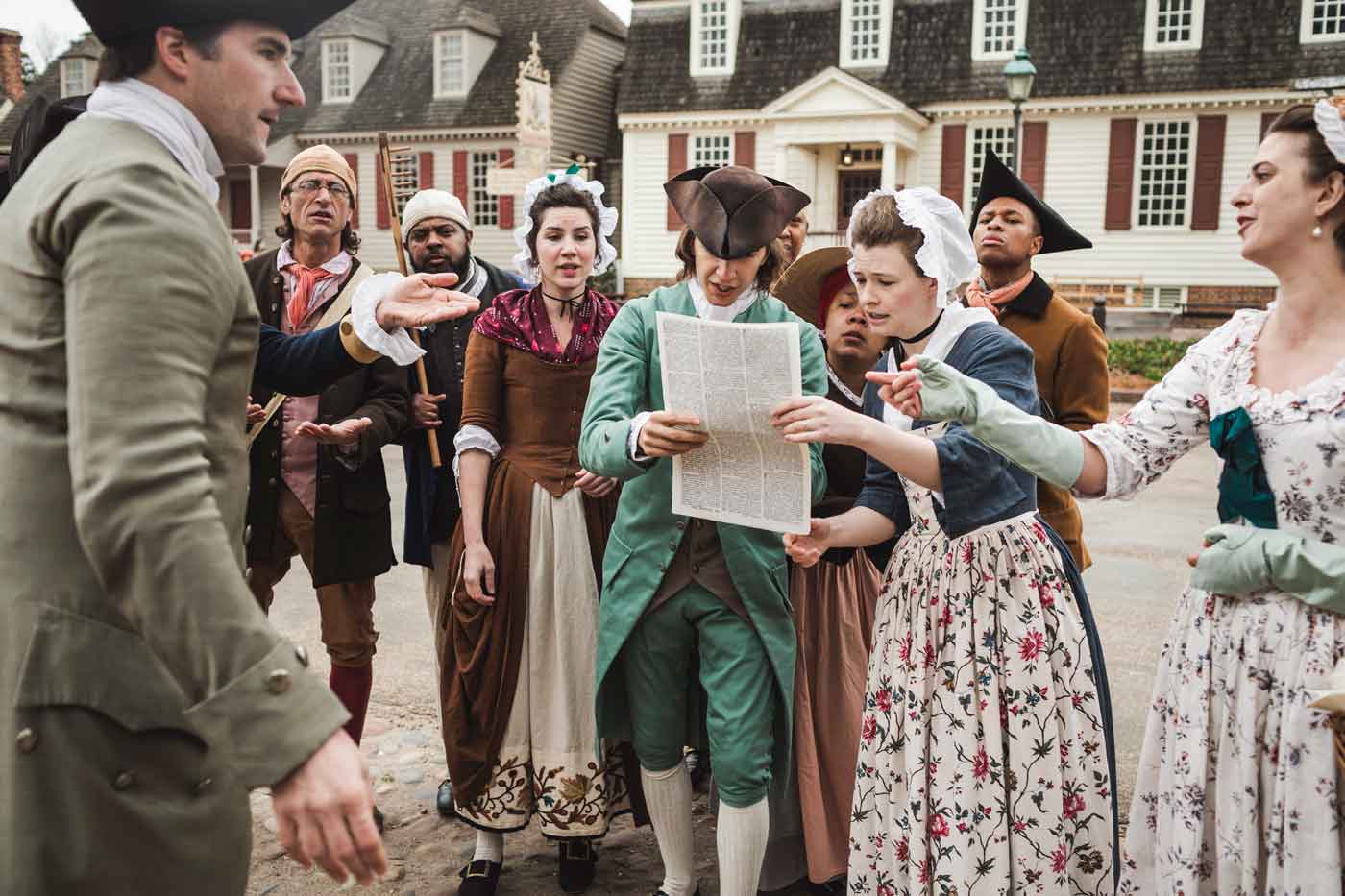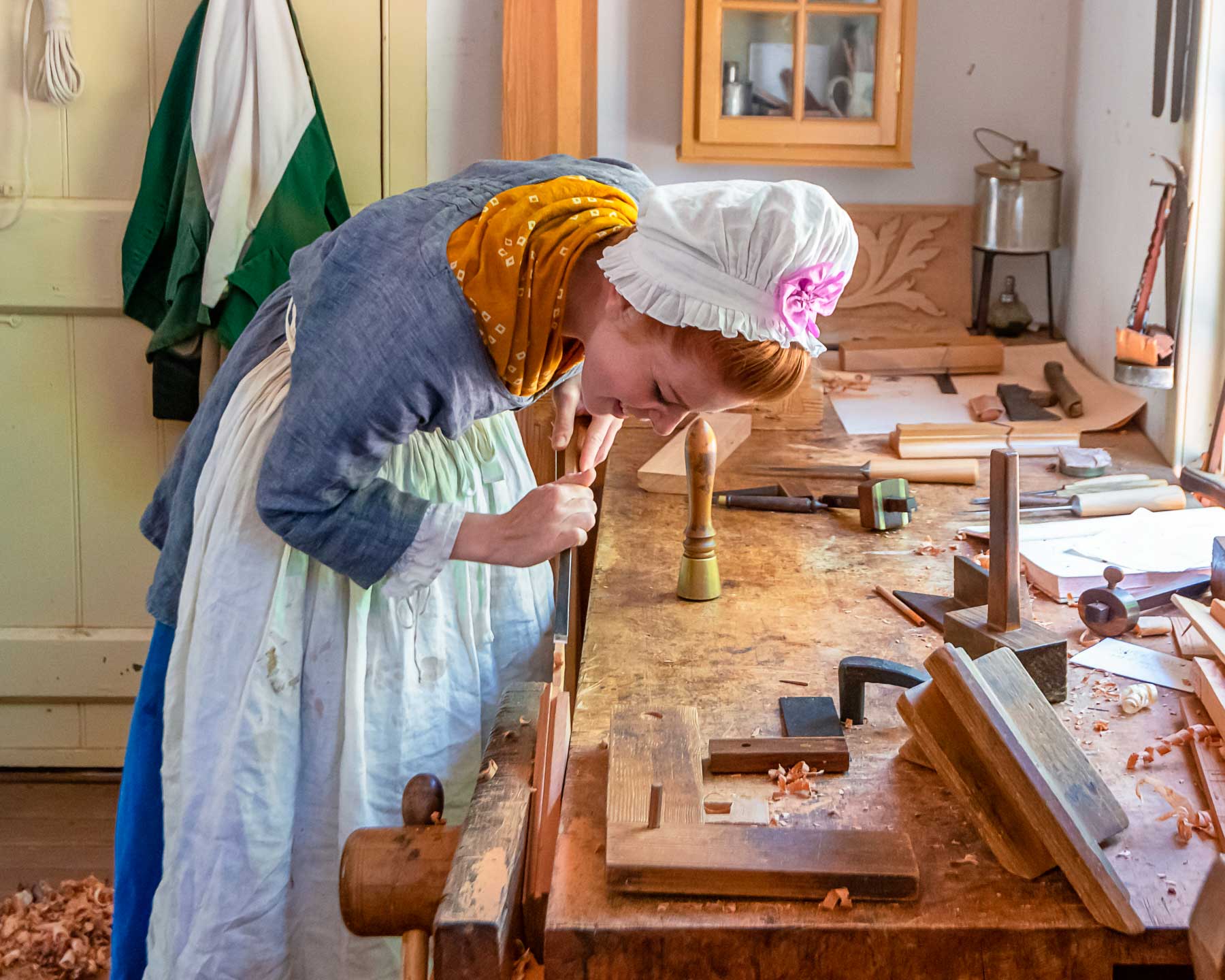Colonial Williamsburg publications & productions:
CW Journal:
- Ed Crews, “Voting in Early America, ” Volume 29, Number 02 (CWJ, Spring 2007), 22-29. After landing, the first order of business for the 1607 Jamestown settlers was the election for council president. By the 18th century, the right to vote was restricted mostly to white, male property holders, 21 years of age or older -- not very democratic or an example of universal suffrage. Some colonies used ballots but Virginia relied on public voice votes. The voting rights struggle lasted well into the 20th century to the civil rights and women's rights movement in the U.S.
- Cathy Hellier, “’Miss in Her Teens’: The Lives of Gentry Girls,” Volume 31, Number 03 (CWJ, Autumn 2009), 54-59. Regimented and carefully monitored, a girl of the gentry class in Virginia found her life similar to that of young women of English nobility. Both were foremost concerned with her proper marriage and her education to the needs of her future life as per her place in society. A major difference in the 18th century was the amount of time spent visiting other relatives in Virginia - thus widening the prospects of girls of courtship age.
- Michael Olmert, “Cool, Calm, Clean,” Volume 28, Number 01 (CWJ, Winter 2006), 68-73. Dairies were the most elaborate of outbuildings, and the cleanest. There are several good examples in the Williamsburg area. Dairies were the province of women and the derivation of the word "deye" came to represent the idea of the chaste and virginal dairymaids. Dairies or milk houses began to disappear about the time of the Civil War, many becoming summer houses or garden follies.
- Mildred H. Arthur, “The Widow of Westover and Women's Rights, ” Volume 12, Number 04 (CWJ, Summer 1990), 28-34. Treated like a traitor, Mary Willing Byrd declared, "This cannot be called liberty."
Trend & Tradition:
- “Her Story, ” Volume 05, Number 01 (T& T, Winter 2020), 32-37. Women worked through the societal constraints of business, government, and education by navigating the social conventions and legal limitations of the colonial era, but by often subtle methods. They were in all arenas of 18th century life.
- Paul Aron, “'Fighting as a Common Soldier'- Anna Maria Lane, ” Volume 02, Number 02 (T& T, Spring 2017), 86-88. Mystery surrounds the Revolutionary career of Anna Maria Lane who in 1808 was granted an usually generous pension because she was "in the revolutionary war, in the garb, and with the courage of a soldier [and] performed extraordinary military services, and received a severe wound at the battle of Germantown". Other women who were called to battle include Margaret Corbin, Tyonajanegen (an Oneida Indian), Deborah Sampson, Ann Hennis Trotter Bailey and Sally St. Clair.
- Catherine Kerrison, “By the Book: How Novels Filled Intellectual Voids in the Lives of Colonial Women, ” Volume 02, Number 02 (T& T, Spring 2017), 78-84. The early 18th c. limitations of access to books and libraries reflected the prevailing beliefs that women's subordinate status, instituted by divine and natural law, best suited then to domestic duties rather than intellectual achievement. The growth of evangelical Christianity opened an intellectual window for women in both reading and writing, and the novel expanded 18th c. horizons.
- Lindsay Keiter, “More Power to You,” Volume 02, Number 02 (T&T, Spring 2017), 72-77. Abigail Adams gave voice in her letters to John Adams to the imbalance of 18th c. marriage in which coverture, the heavy legal limits imposed on women re property rights and money management, left women vulnerable to neglect or financial insecurity. Unlike Abigail and John's long and happy marriage, those of the daughter and granddaughter of Thomas Jefferson were saddled with debt by abusive and alcoholic husbands.
- Holly A. Mayer, “Camp Followers: Soldiering but not Soldiers, ” Volume 01, Number 04 (T& T, Autumn 2016), 100-106. Thousands of women and children accompanied the Continental Army between its birth in 1775 and disbandment in late 1783 as "sutlers and retainers to a camp". The Articles of War described sutlers as camp peddlers and retainers included contractors, family members, servants and slaves. The life of Sarah Osborn, a military wife and campfollower is documented among many others.
- Susan Berg, “Female Entrepreneurs in 18th-c. Williamsburg, ” Volume 01, Number 01 (T& T, Winter 2016), 52-58. Although married women essentially relinquished their legal and economic identities unmarried or widowed women were not as restricted. Profiled are Jane Vobe, Tavern Keeper 1765-85; Catherine Rathell, Milliner mid1760's to 1775; Clementina Rind, Printer 1773-4; and Christiana Campbell, Tavern Keeper early 1750's to late 1780's.
Education Resource Library
Explore our Electronic Field Trips, part of our
Education Resource Library.
Online Primary Sources:
- Hening’s Statutes at Large: digitized and available through HathiTrust
- Virginia Gazette: digitized issues available through Rockefeller Library’s website
Books and Articles:
- Brenner, Alletta. “’The Good and Bad of that Sexe’: Monstrosity and Womanhood in Early Modern England.” Intersections, vol. 10, no. 2 (2009): 161-175. Washington.edu:
- Brown, Kathleen M. Good Wives, Nasty Wenches, and Anxious Patriarchs: Gender, Race, and Power in Colonial Virginia. Chapel Hill: University of North Carolina Press for Omohundro Institute of Early American History and Culture, 1996. Rockefeller Library catalog
- Conger, Vivian Bruce. The Widow's Might: Widowhood and Gender in Early British America. New York: New York University Press, 2009. Rockefeller Library catalog:
- Ferrari, Mary. "Obliged to Earn Subsistence for Themselves": Women Artisans in Charleston, South Carolina, 1763-1808.” The South Carolina Historical Magazine, vol. 106, no. 4 (October 2005), 235-55. JSTOR
- Gundersen, Joan Rezner. “The Double Bonds of Race and Sex: Black and White Women in a Colonial Virginia Parish.” The Journal of Southern History52, no. 3 (1 August 1986), 351-72. JSTOR
- Kerrison, Catherine. “By the Book: Eliza Ambler Brent Carrington and Conduct Literature in Late Eighteenth-Century Virginia.” Virginia Magazine of History105 (1997):27-52. (Includes the story of Rachel Warrington in late eighteenth-century Yorktown and Williamsburg.)
- Kierner, Cynthia A. and Sandra Gioia Treadway, eds. Virginia Women: Their Lives and Times. Athens: University of Georgia Press, 2015. Rockefeller Library catalog:
- Kolp, John G., and Terri L. Snyder. "Women and the Political Culture of Eighteenth-Century Virginia: Gender, Property Law, and Voting Rights."In The Many Legalities of Early America, edited by Christopher L. Tomlins and Bruce H. Mann. Chapel Hill: University of North Carolina Press for Omohundro Institute of Early American History and Culture, 2001. Rockefeller Library catalog
- Lewis, Jan and Kenneth A. Lockridge. "'Sally Has Been Sick': Pregnancy and Family Limitation Among Virginia Gentry Women, 1780-1830."Journal of Social History22 (1988):5-20. JSTOR
- Lockridge, Kenneth. On the Sources of Patriarchal Rage: The Commonplace Books of William Byrd and Thomas Jefferson and the Gendering of Power of the Eighteenth Century. New York: NYU Press, 1992. Rockefeller Library catalog
- Meacham, Sara Hand. Every Home a Distillery: Alcohol, Gender, and Technology in the Colonial Chesapeake. Baltimore: Johns Hopkins University Press, 2009. Rockefeller Library catalog
- Meacham, Sara Hand. “Keeping the Trade: The Persistence of Tavernkeeping among Middling Women in Colonial Virginia.” Early American Studies31, no. 1 (April 2005), 140-163. JSTOR
- Morgan, Philip D. Slave Counterpoint: Black Culture in the Eighteenth-Century Chesapeake & Low Country. Chapel Hill, 1998. Rockefeller Library catalog: Rockefeller Library catalog
- Morris, Michaell P. The Bringing of Wonder: Trade and the Indians of the Southeast, 1700-1783. Westport, Conn., 1999. Includes “Walkers Between Two Worlds: Native American Women and Trade, ” “Mary Musgrove and Nancy Ward: Beloved Women of the Southern Indians, ” “Trade and Indian women in Southeastern America, 1700-1783.” Rockefeller Library catalog
- Nicholls, Michael L. "Aspects of the African American Experience in Eighteenth-Century Williamsburg and Norfolk."A Report Prepared for the Colonial Williamsburg Foundation with the Support of the AT& T Foundation. October 1990.
- Nicholls, Michael L. “The Son of a Certain Woman: Crossing Boundaries of Slavery and Race in Early National Virginia.” The Virginia Magazine of History and Biography124, no. 1 (2016), 2-27. JSTOR
- Norton, Mary Beth. Separated by Their Sex: Women in Public and Private in the Colonial Atlantic World. Ithaca, New York: Cornell University Press, 2011. Rockefeller Library catalog
- Pagan, John Ruston. Anne Orthwood's Bastard: Sex and Law in Early Virginia. New York: Oxford University Press, 2003. Rockefeller Library catalog
- Purdue, Theda. Cherokee Women: Gender and Culture Change, 1700-1835. Lincoln: University of Nebraska Press, 1998. Rockefeller Library catalog
- Rountree, Helen C. The Powhatan Indians of Virginia: Their Traditional Culture. Norman: University of Oklahoma Press, 1989. Rockefeller Library catalog
- Smith, Kimberly A. "'The First Effort of an Infant Hand’: An Introduction to Virginia Schoolgirl Embroideries, 1742-1850." Journal of Early Southern Decorative Arts (Fall 1990). Internet Archive (open access)
- Snyder, Terri L. Brabbling Women: Disorderly Speech and the Law in Early Virginia. Ithaca, New York: Cornell University Press, 2003. Rockefeller Library catalog:
- Speth, Linda E. "More than Her 'Thirds': Wives and Widows in Colonial Virginia." In Women, Family, and Community in Colonial America: Two Perspectives, edited by Linda E. Speth and Alison Duncan Hirsch. New York: Haworth Press, 1983. Rockefeller Library catalog
- Steele, Brian. “Thomas Jefferson’s Gender Frontier,” Journal of American History (June 2008), 17-42. JSTOR
- Stevenson, Kaylan Michelle. "’Her Correspondence is Dangerous’: Women in the Fashion Trades Negotiating the Opportunities and Challenges of Doing Business in the Chesapeake, 1766-75.” M.A. thesis, College of William and Mary, 2013. William & Mary ScholarWorks
- Sturtz, Linda L. Within Her Power: Propertied Women in Colonial Virginia. New York: Routledge, 2002. Rockefeller Library catalog
- Walsh, Lorena. From Calabar to Carter’s Grove: The History of a Slave Community. Charlottesville, 1997. Rockefeller Library catalog







